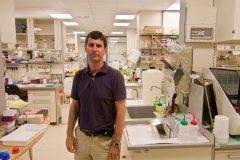
2011/09/26
A consortium of Basque institutions patents a product to foretell drug-related hepatic toxicity
- The project, named LIVERTOX, involves the research centre CIC bioGUNE and the companies Owl Genomics, MD Renal and Faes Farma. It has been funded by the Bizkaia Provincial Council.
- In addition to its clinical relevance, hepatotoxicity is the most frequent reason to take a drug off the market.
- This project has recently been published in Metabolomics.
(Bilbao, 26 September 2011).- The important scientific, technological and medical breakthroughs of the past years have contributed to the development of a great variety of drugs seeking to alleviate the symptoms of many different diseases. The development of such drugs implies a long - 15 to 20 years - and costly process that goes from the initial basic research - the pre-clinical phase - in research labs, to pre-clinical trials in animal models, and different clinical trials before the drugs can be marketed.
However, and despite the strict controls established for the development process, many drugs have to be withdrawn from the market after detecting that they generate adverse effects - especially hepatic - not been detected in any of the previous development phases.
Drug-related hepatotoxicity, therefore, is responsible for 5% of hospital admissions and 50% of cases of acute hepatic failure. Thus, it is currently the most frequent cause for drug withdrawal from the market, with all its possible medical and economical consequences for the pharmaceutical industry.
In response to these problems, a Basque consortium made up by scientific institutions (CIC bioGUNE), biotech companies (Owl Genomics, MD Renal) and pharmaceutical (Faes Farma), funded by the Bizkaia Provincial Council through its Promotion of Innovation and Cooperation Programme, has identified and patented a set of serum molecules which are able to detect and quantify hepatic toxicity non-invasively.
This innovative strategy uses metabolomics, a new technology enabling the analysis of hundreds of metabolites at the same time, in combination with animal testing and histological and biochemical tissue analyses, using computerised data integration and processing. The Basque consortium has been working on the LIVERTOX project since January 2010.
In parallel, the project coordinated by Dr. Juan Manuel Falcón, Ikerbasque researcher belonging to the Metabolomics Unit of CIC bioGUNE, has been recently published in the prestigious journal Metabolomics. "It is important to highlight that our results have allowed us to successfully validate the strategy developed by CIC bioGUNE and its collaborators. Thus, this research line could spread to other biomedical fields, such as the identification of biomarkers to predict the response to the administration of certain drugs", said Juan Manuel Falcón.
Liver Damage
Hepatic lesions can present different severity degrees and show diverse clinical signs including steatosis, hepatitis, fibrosis, cirrhosis and hepatocellular carcinoma. Obesity, type II diabetes, viral infections and drug-induced hepatotoxicity are the most common causes for liver damage. Besides the clinical importance, hepatotoxicity is the most frequent reason for drug withdrawal from the market, thus having a great economic impact in the pharmaceutical industry.
Currently, the determination of liver damage type and extension is done through liver biopsies and enzyme tests. These techniques are either invasive and have a great amount of false positives, or show low sensitivity and specificity levels, which prevents early and efficient liver damage detection. Metabolomics is a quick and highly sensitive new technology for the analysis of a large range of metabolites in biological fluids. Therefore, LIVERTOX "is innovative; its non-invasiveness and easy use facilitate its application and commercialisation. It has shown high sensitivity and specificity levels and, therefore, allows for early detection of possible liver damage", in the words of Juan M. Falcón, project coordinator.
Another significant aspect, in Dr. Falcón's opinion, is that this project includes "a complete chain of value: research centres and biotech companies, addressing the development of advanced scientific solutions, and the end client - the pharmaceutical industry - involved in their development and marketing".
See a large version of the first picture





